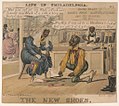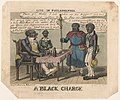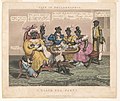| Plate | Image | Artist | Publisher | Year | Captions | Notes |
|---|
| Tregear-1 |  | William Summers | G. S. Tregear,
London | c.1833 | "Dark Conversation."
"Bery Black looking day dis Mons'r."
"Yes Bery stormy. De Blacks flying about so make it Petickly Disagreable." | |
| Tregear-2 | | William Summers | G. S. Tregrear,
London | c.1833 | "An Unfair Reflection."
"It was bery Unfair ob Mifs Carolina to Reflect on de Palenefs ob my Complexion. I consider dat I hab got a bery Good Color." | |
| Tregear-3 |  | William Summers | G. S. Tregear,
London | c.1833 | "The New Shoes." | |
| Tregear-4 |  | William Summers | G. S. Tregear,
London | c.1833 | "The Lub Letter." | |
| Tregear-5 |  | William Summers | G. S. Tregear,
London | c.1833 | "A Black Charge."
"Please y-'r Worship I hab taken up dis Nigger!! case he-'s -nebriated and -sulting to de Fair sec." | |
| Tregear-6 |  | William Summers | G. S. Tregear | c.1833 | "The Valentine."
"Holl'a! What's all dis about—
'De rose is Red de Violets blue'
'De Debil's Black and so are You.'
Well dat's bery Fair indeed." | |
| Tregear-7 |  | William Summers | W. H. Isaacs,
London | c.1833 | "A Black Tea Party." | |
| Tregear-8 |  | unidentified
(after Edward W. Clay) | Harrison Isaacs,
London | c.1831 | "How you find yourself dis hot Weader Mifs Chloe?"
"Pretty well tank you Mr. Cesar only I aspire too much!" |
Plate 3 in the first London edition |
| Tregear-9 |  | unidentified
(after Edward W. Clay) | Harrison Isaacs,
London | c.1831 | "Have you any Flesh coloured Silk Stockings, young man?"
"Oui Madame! here is von pair of de first qualité!" | Reversed image of Plate 11 in the original series
|
| Tregear-10 |  | William Summers | Harrison Isaacs,
London | c.1833 | "A Black Ball. La Pastorelle."
"What a figure Bruder Brutus look cutting him capers dare by himself." | |
| Tregear-11 |  | I. Harris
(Edward W. Clay) | W. H. Isaacs,
London | 1833 | "Grand Celebration Ob De Bobalition Ob African Slabery." |
The 1833 Slavery Abolition Act ended slavery in the British colonies. |
| Tregear-12 |  | William Summers | W. H. Isaacs,
London | c.1833 | ROMEO._"How Silber sweet, sounds Lubbers Tongues by Night; like sorptest Music to attending Ears."
JULIET._"Dou know'st de mask ob night is on my face, else would a maiden blush bepaint my cheek." | |
| Tregear-13 | | William Summers | W. H. Isaacs,
London | c.1833 | "A Crier Extraordinary." | |
| Tregear-14 |  | unidentified
(after Edward W. Clay) | W. H. Isaacs,
London | c.1831 | "What you tink of my new poke Bonnet, Frederich Augustus?"
"I don't like him no how, 'case dey hide you Lubly Face, so you can't tell one She Nigger from anoder." | |
| Tregear-15 |  | unidentified
(after Edward W. Clay) | Harrison Isaacs,
London | c.1831 | "Hurrah! Hurrah for General Jackson!!"
"What de debil you hurrah for General Jackson for?—you black Nigger!—I'll larn you better.—I'm a 'ministration Man!!" |
Plate 5 in the first London edition |
| Tregear-16 |  | unidentified
(after Edward W. Clay) | Harrison Isaacs,
London | c.1831 | "Shall I hab de honour to dance de next Quadrille wid you, Mifs Minta?"
"Tank you Mr. Cato,—wid much pleasure, only I'm engaged for de nine next set!" |
Plate 6 in the first London edition |
| Tregear-17 |  | unidentified
(after Edward W. Clay) | Harrison Isaacs,
London | c.1831 | "Is Mifs Dinah at home?"
"Yes sir but she bery petickly engaged in washing de dishes."
"Ah! I'm sorry I can't have the honour to pay my devours to her. Give her my card." |
Plate 11 in the first London edition |
| Tregear-18 |  | William Summers
(after Edward W. Clay) | Harrison Isaacs,
London | c.1831 | "How you like de new fashion shirt, Mifs Florinda?"
"I tink dey mighty eligum—I see you on new year day when you carry de colour on de Abolition 'siety—you look just like Pluto de God of War!" |
Plate 9 in the original series; Plate 9 in the first London edition |
| Tregear-19 |  | unidentified
(after Edward W. Clay) | Harrison Isaacs,
London | c.1831 | "Take away, take away dose rosy lips,
Rich, rich in balmy treasure!—
Turn away, turn away dose eyes ob lub,
Lefs I die wid pleasure!!!"
"Dat is bery fine, Mr. Mortimer,—you sing quite con a moor, as de Italians say!!" |
Plate 2 in the first London edition |
| Tregear-20 |  | unidentified
(after Edward W. Clay) | Harrison Isaacs,
London | c.1831 | "How you like de Waltz, Mr. Lorenzo? I bery fond of it."
" 'Pon de honour ob a gentleman I tink it vastly indelicate, only fit for de common people!! I wonder how de fair sec can admire it.—" |
Plate 13 in the first London edition |
| Isaacs-8 | | William Summers
(after Edward W. Clay) | Harrison Isaacs,
London | c.1831 | "Good evening Mifs, shall I have the pleasure of walking with you?"
"Me Sir!! for whom do you take me, Sir?"
"Come, that's a good one!—for whom do I take you? why for myself to be sure!" |
Plate 8 in the original series; Plate 8 in the first London edition;
not reprinted in Tregear. |
| Isaacs-10 | | H. Harrison
(after Edward W. Clay) | W. H. Isaacs,
London | c.1833 | "Life in Philadelphia." "Sketches of Character." "At Home." "Abroad." |
Not part of the original series or the first London edition.
Self-published by Edward W. Clay, Philadelphia, 1830.
Two images printed on a single sheet
Added to London edition, c.1833; reprinted in Tregear, 1834. |
| Isaacs-11 | | William Summers
(after Edward W. Clay) | Harrison Isaacs,
London | c.1831 | "Behold, thou art fair Deborah, thou hast doves eyes. Behold thou art fair Deborah,
yea pleasant!" |
Plate 2 in the original series; Plate 11 in the first London edition;
not reprinted in Tregear.
Replaced c.1833, by a cartoon about the abolition of slavery in the British colonies. [1] |
| Isaacs-? |  | Unidentified
(after Edward W. Clay) | W. H. Issacs,
London | c.1832 | "The Cut Direct. or How to get up in the World." |
Not part of the original series or the first London edition.
Published by Susan Hart, Philadelphia, 1829, as "A Dead Cut."
Added to London edition, c.1832; reprinted in Tregear, 1834. [1] |
| Isaacs-? | | unidentified | W. H. Isaacs,
London | c.1835 | "Life in Philadelphia." "General Order!! Tention!!"
"Philadelphia_Uly 14_1825_& little arter_"
"That is de day ob de grand Celebrashun_" | |









































